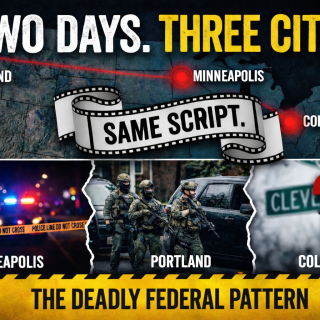After more than 150 years, The Ohio State University (OSU) does not understand that it is now completely within and surrounded by – and has legal responsibilities to – the city of Columbus and its residents.
Among large urban university campuses and their adjoining residential districts, OSU and the University District are among the most dangerous in the US. As I was in the process of submitting this article, DegreeChoices.com released a new national report that found OSU to be the second “most dangerous campus” in the United States, based on data from the U.S. Department of Education on violent crimes committed and/or reported in 2019-2021. OSU had 583 reported incidents.
OSU has a campus security force of less than 80 for a student, faculty, and staff campus of almost 90,000. The Columbus Police has no regular presence in the University District. For good reasons, students do not want to see them on campus. In 1970, for example, the Columbus Police Department (CPD) and the National Guard rioted on campus.
Although both OSU and CPD have no reliable accounting or reporting, the campus rivals the former dangers of truly urban Chicago, Columbia, Penn, Temple, Wayne State, among others.
Critically, that is: without the racial and poverty elements. That’s a powerful set of contradictory relationships. Despite their location in much more tenuous urban areas, most universities have improved safety. OSU moves in the opposite direction.
Outgoing President Kristina Johnson responded to a relatively small increase in campus area reported offenses in August and September 2022 by first exaggerating its extent, and then with slogans and undelivered promises of funding more security. Her signature (in)action was the actually harmful portable lamp posts, endlessly touted with no credible evidence. She lied about bare numbers. Only four months later, she hired an unqualified “consulting firm” in the Columbus suburbs to vindicate her actions. They failed.
Now OSU brags about the presence of “4,000” cameras on and off campus. But look at them in clusters of 10s and 20s, often in well-lit locations. And, of course, there is not a word about their actual effectiveness. Yet another OSU-trademark physical location substituting inadequately for action in the form of policies, programs, budgets, timetables, and accountability.
Recently I had occasion to walk to and across campus several times in a few weeks: to see an exhibit, meet with colleagues/friends and some administrators, plan a celebration/reunion with dozens of my former graduate students for May 2024, and participate in a senior honors thesis defense.
Much more than at any time since I joined OSU in September 2004, the campus is fundamentally unsafe.
1. There is no visible presence of security. It is rumored that there are plain clothes officers,
but if present, they do nothing.
2. There is no signage regarding safety or the law anywhere.
3. Almost all students have ear plugs or headphones, and/or are looking at their phones. A number literally walked into me or didn’t allow me to pass them. Only a few apologized. Most swore at me. The favorite, repeated line from the young Buckeyes is “fuck off, old man.”
4. The sidewalks are also filled with racing scooters, bikes, skateboards, and robots all running into people. The first two are illegal on sidewalks anywhere in the City of Columbus including the OSU campus. When I asked them to move from the sidewalks, only one apologized and complied. All others screamed profanities and continued almost running into anyone in their path and each other.
5. Scooters as well as bicycles are left blocking sidewalks, driveways, and doorways with no regulation or clearing. This is also illegal.
6. Whether on foot or vehicles, few students obey stop signs or stop lights.
7. Nowhere are the laws brought to students’ attention. Not on Student Life websites. Not in other forms. Not posted on campus.
8. The use of short, non-required, uninformative videos for safety training is radically inadequate, my student friends and neighbors repeatedly tell me and each other. They are not serious safety measures. They mainly serve to absolve the university of liability.
OSU has almost completely stopped sending out crime reports and safety alerts. It is incapable of doing that. On one hand, the university refers to the almost useless Lexis-Nexis incomplete, repetitive, and never corrected daily bulletins which are dramatically incomplete. But, on the other hand, the leaders of Campus Security tell me that they pay no attention to them. Huh?
When Campus Security sends out its own rare alerts, they are typically late, incomplete, and confusing. They continue to include the long-out-of-date sentence, no longer required by the federal Clery Act: “The victim is never responsible for the crime.”
That is false, and very misleading to an 18-26 year old. Campus Security had been told this repeatedly, to no effect. Contradiction and counter-productivity is part of the OSU Way.
Unlike nearby Ohio University and Bowling Green State University and many others, OSU does not regularly report rapes. Multiple sources underscore their frequency in dormitories, rental houses of the “bad kids” and “juvenile delinquents,” and fraternities. These are criminal offenses.
OSU also does not report what is common knowledge around campus: the substantial exodus from the profit-making required second year in campus dorms because of rapes, nudity and exposure, and the two old towers literally falling down.
Why did it take more than two years of constant auto thefts for OSU to take any action?
Does anyone at OSU actually believe that distributing free tiny toy noisemakers is a serious response to a student confronting a gang or a gun? Yet another silly physical slogan.
Why do Campus Security, Bricker Hall, or Student Life say nothing about the report publicized in the student newspaper The Lantern on Feb. 8, 2023: Ohio State leads the Big Ten (now 14) in the minimum number of reported hate crimes with almost double the number of arch-rival Michigan (with or without its M)? Silence is damning.
When more life-threatening violence, most likely with guns, comes, as it certainly will, OSU remains almost completely unprepared. The repeated lesson with each case from Virginia to Michigan State and beyond is the immediacy, completeness, and clarify of messaging to the entire community.
OSU is incapable of that. To quote The Lantern (Feb. 27, 2023), repeating Campus Security and
OSU Marketing and Communications: “Though Buckeye Alerts, educational videos on what to do during an active threat, as well as annual University Police Division training, the university methods to protect the community. Ohio State safety professionals look to reassure and remind the community….”
No one can be reassured by this inadequacy. OSU Campus and the UD are very unsafe. The University, City, and landlords are silent. Residents, including homeowners, many students, and parents are not.
Is anyone listening?
As noted above, OSU does not regularly report campus or campus-area crime. It is very likely that OSU ranks first in the DegreeChoices.com this critical category, unlike any others.
For more information, see https://www.degreechoices.com/blog/most-dangerous-college-campuses/ and https://res.cloudinary.com/teamodeon/image/upload/v1683121613/degreechoices/PR%20Downloadables/Degreechoices_most_ dangerous_colleges.jpg
References
Ellen Manovich, “‘Is This a Real Neighborhood’: Universities, Urban Development, and
Neighborhood Change in the 20 th Century United States,” unpublished Ph.D. Diss., University of
Minnesota. 2016
_____,“‘Time and Change Will Surely Show’: Contested Urban Development in Ohio State’s
University District, 1920-2015,” Journal of Social History 51(2018) , 1069-1099.
By Harvey J. Graff
“The decline of a once vital neighborhood: Columbus’ University District,” Columbus Free
Press, Sept 14, 2021
“For Ohio State, bigger is not better,” Columbus Free Press, Sept. 16, 2021
“Columbus’ University District: Students and the institutions that fail them,” Columbus Free
Press, Oct. 8, 2021
“OSU isn’t having a crime crisis; it’s having a leadership crisis,” Busting Myths, Columbus Free
Press, Nov 2, 2021
“‘Update’ to Ohio State isn’t having a crime crisis,” Busting Myths, Columbus Free Press, Nov.
13, 2021
“The Ohio State University promotes public health crises,” Busting Myths, Columbus Free
Press, Dec. 6, 2021
“OSU Falters Once Again, a continuing tragedy,” Busting Myths, Columbus Free Press, Feb. 28,
2022
“Ohio State versus ‘campus safety,’” Busting Myths, Columbus Free Press, Mar. 13, 2022
“How Columbus, Ohio State University, and major developers destroyed a historic
neighborhood,” Busting Myths, Columbus Free Press, Part One, Apr. 26, 2022
“How Columbus, Ohio State University, and major developers destroyed a historic
neighborhood,” Busting Myths, Columbus Free Press, Part Two, Apr. 29, 2022
“How Columbus, Ohio State University, and major developers destroyed a historic
neighborhood—a continuing saga,” Busting Myths, Columbus Free Press, May 2, 2022
“Universities are not giving students the classes or support they need,” Times Higher Education,
May 17, 2022
“How Young People Have Changed,” Letter to the Editor, Inside Higher Education, Aug. 4,
2022
“Recreating universities for the 21 st century without repeating the errors and myths of the 20 th
century?” Busting Myths, Columbus Free Press, Aug. 7, 2022
“The United States’ most disorganized university? Ohio State’s ‘5½ D’s’: Disorganization,
dysfunction, disengagement, depression, dishonest, and undisciplined, Part One,” Busting Myths,
Columbus Free Press, Aug. 28, 2022
“The United States’ most disorganized university? Ohio State’s ‘5½ D’s’: Disorganization,
dysfunction, disengagement, depression, dishonest, and undisciplined, Part Two,” Busting
Myths, Columbus Free Press, Aug. 31, 2022
“Universities Must Help the New ‘Lost Generation,’” Academe Blog, Sept. 16, 2022
“Growing up was always hard to do. It’s getting harder, and universities are doing little to help,”
Busting Myths, Columbus Free Press, Sept. 26, 2022
“The City of Columbus and The Ohio State University: Two peas in a pod, one bigger than the
other, relatively speaking, but so much the same. Part One,” Busting Myths, Columbus Free
Press, Oct. 8, 2022
“The City of Columbus and The Ohio State University: Two peas in a pod, one bigger than the
other, relatively speaking, but so much the same. Part Two,” Busting Myths, Columbus Free
Press, Oct. 14, 2022
“The OSU Way: Slogans over Truth and Honesty in Graduation Rates and Student Well-Being,”
Busting Myths, Columbus Free Press, Oct. 27, 2022
“How universities fail their students: The president may be “born to be a Buckeye,” but the
students are not. A call to eliminate Offices of Student Life and invest directly in students’
lives,” Busting Myths, Columbus Free Press, Nov. 10, 2022
“University bragging rights: OSU whimpers but doesn’t bite or swallow,” Busting Myths,
Columbus Free Press, Nov. 27, 2022
“Columbus’ home grown illegal landlords in a destroyed historic district,” Busting Myths.
Columbus Free Press, Dec. 11, 2022
“I’m retired but I’ll still running my own unofficial university,” Times Higher Education, Dec
21, 2022
“The Ohio State University: Not ‘a failed presidency,’ by itself, but a failing university, Part
One,” Busting Myths, Columbus Free Press, Jan. 7, 2023
“The Ohio State University: Not ‘a failed presidency,’ by itself, but a failing university, Part
Two,” Busting Myths, Columbus Free Press, Jan. 11, 2023
“Columbus, Ohio: Rude and Crude: The little big city that refuses to represent. serve, or respect
its publics, Part One,” Busting Myths, Columbus Free Press, Jan. 15, 2022
“Columbus, Ohio: Rude and Crude: The little big city that refuses to represent. serve, or respect
its publics, Part Two,” Busting Myths, Columbus Free Press, Jan. 19, 2023
“Universities and cities often fail both homeowners and students,” Times Higher Education, Jan.
22, 2023
“A city versus its neighborhoods: Columbus, Ohio,” Busting Myths, Columbus Free Press, Jan.
25, 2023
“Unsafe at any speed: The unsafe city—from mayor to city council to CPD,” Busting Myths,
Columbus Free Press, Feb. 16, 2023
“Kristina Johnson breaks her two-and-a-half months of silence and begins an anti-factual, myth
making campaign for rehabilitation,” Busting Myths, Columbus Free Press, Feb. 22, 2023
“Lessons from the 1960s: Paths to Rediscovering Universities,” Against the Current, 223, Mar.-
Apr., 2023, 12-14
“J’accuse: The City of Columbus Division of Public (aka Private) Service,” Busting Myths,
Columbus Free Press, Mar. 3, 2023
“The Ohio Student University vs. The Students, The Law, and The Truth. The Victims of Dr.
Richard Strass and of OSU,” Busting Myths, Columbus Free Press, Mar. 14, 2023
“How can a city with no history destroy its history? The Columbus Way,” Busting Myths,
Columbus Free Press, Mar. 18, 2023
“A call for reparations from the City of Columbus, the large corporate landlords, and The Ohio
State University for the destruction of neighborhoods with a focus on the University District,”
Busting Myths, Columbus Free Press
“Living in a University District: How universities and their cities fail both homeowners and
student renters,” forthcoming
“Disconnecting Gown and Town: Campus Partners for Urban Community Development, Ohio
State University,” forthcoming
---------------------------------------
Harvey J. Graff is Professor Emeritus of English and History at The Ohio State University and
inaugural Ohio Eminent Scholar in Literacy Studies. Author of many books, he writes about a
variety of contemporary and historical topics for Times Higher Education, Inside Higher
Education, Academe Blog, Washington Monthly, Publishers Weekly, Against the Current,
Columbus Free Press, and newspapers. Searching for Literacy: The Social and Intellectual
Origins of Literacy Studies was published by Palgrave Macmillan in 2022. My Life with
Literacy: The Continuing Education of a Historian. The Intersections of the Personal, the
Political, the Academic, and Place is forthcoming. “Reconstructing the ‘uni-versity’ from the
ashes of the ‘multi- and mega-versity’” is in progress.



